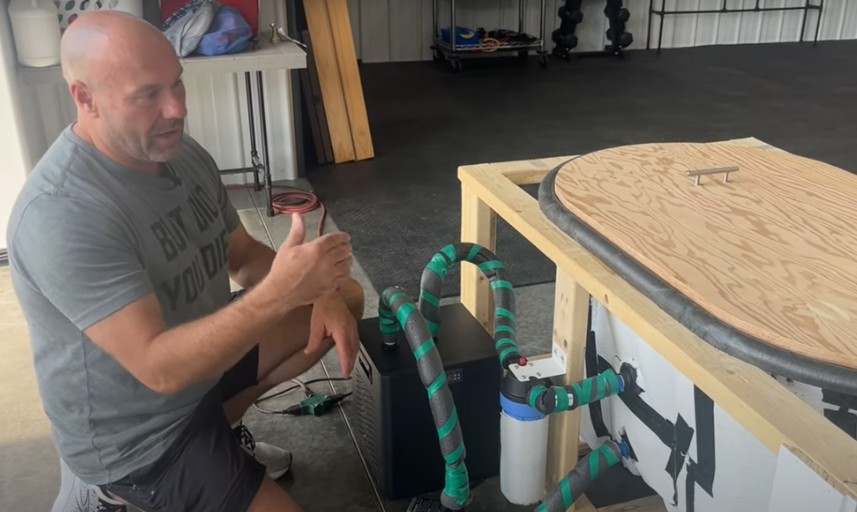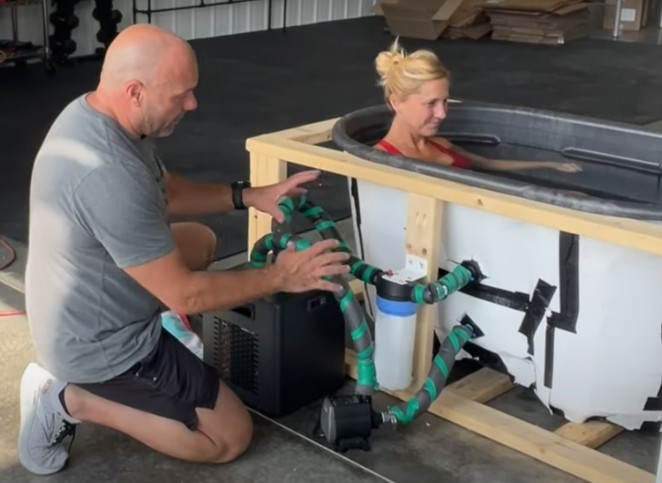Need help?
Unsure whether you need a bath or a plunge, portable or fixed, chiller or iced? Check out Sasha’s cold plunge vs ice bath article to answer all and get clarity on your cold immersion needs.
As an avid fitness enthusiast and self-experimenter, I’ve always been drawn to pushing my physical limits. From ultramarathons to high-altitude mountaineering, I’ve put my body through it’s paces.
But nothing quite prepared me for the shock and exhilaration of cold water immersion therapy.
Six months ago, I embarked on a comprehensive testing journey for the perfect Cold Plunge Chiller. These devices, essentially high-tech ice baths, maintain water at consistently cold temperatures, typically between 39°F to 59°F (4°C to 15°C).
This temperature range is crucial – cold enough to trigger the physiological responses we’re after, but not so frigid as to be dangerous.
>>Make sure you check out Greg’s post on the best chillers out there right now<<
Contents
- 1 The Evolution of My Cold Plunge Practice
- 2 The Nuts and Bolts of Cold Plunge Chillers
- 3 Advanced Features That Make a Difference
- 4 The Science Behind Cold Water Therapy
- 5 Unexpected Benefits of Cold Plunge Therapy
- 6 Pushing Boundaries Safely
- 7 Is a Cold Plunge Chiller Worth the Investment?
- 8 Pro Tips for Maximizing Your Cold Plunge Experience
- 9 Common Pitfalls to Avoid
- 10 Exercises to Enhance Your Cold Plunge Experience
- 11 The Future of Cold Plunge Therapy
-
12 People Also Asked
- 12.1 What temperature should a cold plunge be?
- 12.2 How long should you stay in a cold plunge?
- 12.3 Can cold plunges help with weight loss?
- 12.4 Are cold plunges safe for everyone?
- 12.5 How often should you do cold plunges?
- 12.6 Can cold plunges improve athletic performance?
- 12.7 What’s the difference between a cold plunge and an ice bath?
- 12.8 Do I need a special tub for a cold plunge?
- 12.9 How much electricity does a cold plunge chiller use?
- 12.10 Can cold plunges help with mental health?
- 12.11 What kind of chiller do I need for a cold plunge?
- 12.12 Can I use an aquarium chiller for my cold plunge?
- 12.13 Is an ice bath chiller worth it?
- 12.14 How do I chill my cold plunge?
- 13 Key Takeaways
The Evolution of My Cold Plunge Practice
My cold water therapy journey began with breaking ice on Michigan lakes for daily dips. While invigorating, this method lacked consistency and convenience.
Enter the cold plunge chiller – a game-changer for at-home cold therapy.
Over the past half-year, I’ve rigorously tested various models, meticulously tracked every conceivable metric, and dove deep into scientific literature to understand the mechanisms behind cold water therapy. The results have been nothing short of transformative.
The Nuts and Bolts of Cold Plunge Chillers
During my testing, I found that the most effective units could cool water from room temperature to the ideal plunge temperature in about 4-6 hours. This quick cooling ability is invaluable for those without access to natural cold water sources.
Energy efficiency was a primary concern of mine. I was pleasantly surprised to explore that some of the more eco-friendly models use as little as 1 kWh per day to maintain temperature – less than running a small space heater for an hour.
Advanced Features That Make a Difference
As I delved deeper into my testing, I realized the vast differences between various cold plunge chillers. The best units I encountered included:
- UV sterilization: This feature provides extra water purification, ensuring you’re not immersing yourself in a bacterial breeding ground.
- Built-in timers and precise temperature controls: These allow for a customizable and gradually progressive cold adaptation process.
- Ozone purification systems: Another layer of water sanitation for peace of mind.
- Saltwater compatibility: This opens up extra therapeutic options.
These features contribute significantly to a safer, more customizable, and ultimately more beneficial cold plunge experience.
The Science Behind Cold Water Therapy
Throughout my six-month journey, I didn’t rely solely on personal experience. I immersed myself in scientific literature to understand the mechanisms behind cold water therapy.
Here are some of the most compelling findings:
- Brown Fat Activation: A 2020 study published in PLOS One found that regular cold water immersion can increase brown fat activity, potentially aiding in weight management.
This aligns with the changes I observed in my body composition over the course of my experiment.
- Immune System Boost: Research from the Netherlands in 2016 showed that cold showers reduced sick leave from work by 29% compared to a control group.
While I can’t claim a dramatic reduction in sick days (I rarely get sick anyway), I did experience an overall sense of improved immune function.
- Enhanced Antioxidant Defenses: A 2018 study in the Journal of Physiology demonstrated that cold water immersion can enhance the body’s antioxidant defenses.
This could explain the general sense of well-being and reduced inflammation I experienced throughout my testing period.
Unexpected Benefits of Cold Plunge Therapy
While improved recovery and reduced inflammation were anticipated benefits, I was surprised by several other effects I experienced and measured during my testing period:
- Enhanced Sleep Quality: My sleep tracker showed a 15% increase in deep sleep after days when I did an evening cold plunge.
As someone who has always struggled with quality sleep, this was a game-changing discovery.
- Improved Focus: I noticed a significant boost in my ability to concentrate for hours after a morning plunge.
The effect was similar to caffeine, but without the jitters or eventual crash.
- Mood Elevation: My daily mood scores (which I track religiously) showed a consistent uptick on days when I used the cold plunge chiller.
This was perhaps the most surprising and welcome benefit.
Pushing Boundaries Safely
As someone who approaches cold water therapy with intense dedication, I’ve learned the importance of pushing boundaries safely. During my testing, I gradually increased my exposure time and decreased the water temperature.
However, I always adhered to strict safety protocols:
- Never Plunge Alone: Cold water can be shocking to the system, and it’s crucial to have someone nearby in case of emergency.
- Limit Sessions to 15 Minutes Maximum: Even as I built up my cold tolerance, I never exceeded this limit.
The benefits don’t increase linearly with time, and prolonged exposure can be dangerous.
- Proper Post-Plunge Warming: This is just as important as the plunge itself.
I developed a routine of light exercise and warm beverages to safely bring my body temperature back up.
- Listen to Your Body: No matter how committed you are to your cold plunge routine, it’s crucial to respect your body’s limits.
I always exited the water if I felt uncomfortable, regardless of how long I had been in.
Is a Cold Plunge Chiller Worth the Investment?

After six months of rigorous testing, tracking, and data analysis, I can confidently say that a high-quality cold plunge chiller is worth the investment. The convenience, consistency, and control offered by these devices far outweigh the initial cost.
However, choosing the right unit for your needs is crucial. Consider factors like:
- Energy efficiency
- Cooling capacity
- Additional features (UV sterilization, ozone purification, etc.)
- Maintenance requirements
- Warranty and customer support
Remember, a cold plunge chiller is a tool, not a secret cure. It’s most effective when used as part of a comprehensive approach to health and wellness that includes proper nutrition, regular exercise, and adequate rest.
Pro Tips for Maximizing Your Cold Plunge Experience
- Start Slow: Begin with shorter durations (30 seconds to 1 minute) and gradually increase your time as your body adapts.
- Use Breathwork: Controlled breathing can help you manage the initial shock of cold water immersion.
Try the Wim Hof method or box breathing.
- Experiment with Contrast Therapy: Alternating between your cold plunge and a hot shower or sauna can amplify the benefits and make the experience more enjoyable.
- Time It Right: Experiment with morning plunges for an energy boost and evening plunges for better sleep.
- Stay Hydrated: Cold water immersion can be dehydrating, so make sure to drink plenty of water before and after your plunge.
Common Pitfalls to Avoid
- Overuse: More is not always better.
Stick to 2-3 plunges per week to start, and listen to your body.
- Neglecting Maintenance: Regular cleaning and water changes are crucial for the longevity of your chiller and your health.
- Inadequate Warm-Up: Always have a plan for warming up post-plunge.
This is not the time to ‘tough it out.’
- Pushing Too Hard: Cold adaptation is a gradual process.
Respect it and don’t try to break records every time.
Exercises to Enhance Your Cold Plunge Experience
- Cold Shower Challenge: Start with 30 seconds of cold water at the end of your regular shower.
Increase by 10 seconds each day until you can comfortably handle 3 minutes.
- Breath Hold Practice: In a safe environment (not in water), practice holding your breath to improve your CO2 tolerance.
This can help manage the initial gasping reflex when entering cold water.
- Mindfulness Meditation: Practice focusing on your breath and body sensations for 5 minutes daily.
This skill will serve you well during cold plunges.
- Gradual Temperature Decrease: If your chiller allows, start at 59°F (15°C) and decrease the temperature by 1°F each week until you reach your target temperature.
- Post-Plunge Journaling: Keep a log of your experiences, noting duration, temperature, and how you feel immediately after and later in the day.
This can help you refine your routine.
The Future of Cold Plunge Therapy
As we continue to explore the boundaries of human performance and well-being, cold plunge chillers will likely play an increasingly important role. Whether you’re an athlete looking to improve recovery, a busy professional seeking stress relief, or simply someone interested in boosting your overall health, a cold plunge chiller could be the game-changing addition to your routine that you’ve been searching for.
People Also Asked
What temperature should a cold plunge be?
Most experts recommend a temperature range between 50-59°F (10-15°C) for beginners. As you build tolerance, you can gradually lower the temperature to 39-50°F (4-10°C).
How long should you stay in a cold plunge?
For beginners, start with 30 seconds to 2 minutes. Gradually increase your time up to a maximum of 15 minutes as your body adapts.
Can cold plunges help with weight loss?
While not a direct weight loss tool, cold plunges can activate brown fat and boost metabolism, potentially aiding in weight management when combined with a healthy diet and exercise.
Are cold plunges safe for everyone?
Cold plunges are generally safe for healthy people, but those with heart conditions, high blood pressure, or other health concerns should ask a doctor before starting.
How often should you do cold plunges?
Most practitioners recommend 2-3 times per week to start. Some people work up to daily plunges, but it’s important to listen to your body and avoid overuse.
Can cold plunges improve athletic performance?
Many athletes use cold plunges for recovery and potential performance enhancement. Research suggests benefits in reducing muscle soreness and inflammation post-exercise.
What’s the difference between a cold plunge and an ice bath?
Cold plunges typically use a chiller to maintain a consistent temperature, while ice baths rely on ice to cool the water. Cold plunges offer more precise temperature control.
Do I need a special tub for a cold plunge?
While dedicated cold plunge tubs exist, many people use regular bathtubs or even large containers with a portable chiller unit.
How much electricity does a cold plunge chiller use?
Energy consumption varies by model, but effective units can use as little as 1 kWh per day to maintain temperature.
Can cold plunges help with mental health?
Many users report improved mood and reduced stress after cold plunges. Some research suggests potential benefits for depression and anxiety, but more studies are needed.
What kind of chiller do I need for a cold plunge?
For a cold plunge, you need a chiller that can maintain water temperatures between 39-59°F (4-15°C) and has at least 1/2 HP cooling capacity. Look for units with UV sterilization, precise temperature control, and the ability to cool 100-150 gallons of water. Dedicated cold plunge chillers are recommended over adapted solutions.
Can I use an aquarium chiller for my cold plunge?
While aquarium chillers can technically cool water, they’re not recommended for cold plunges because they lack sufficient cooling power, aren’t designed for human use, and can’t maintain consistent temperatures in larger volumes of water. They also often lack safety features like UV sterilization and proper filtration systems.
Is an ice bath chiller worth it?
Yes, an Ice Bath Chiller is worth the investment if you’re serious about cold therapy. Quality chillers provide consistent temperatures, convenient daily use, proper sanitization, and precise control – benefits that outweigh manual ice baths. They also save time and money long-term compared to buying ice regularly.
How do I chill my cold plunge?
To chill a cold plunge:
- Monitor water quality with sanitization systems
- Install a dedicated cold plunge chiller (most efficient)
- Use a combination of ice and water (manual method)
- Connect the chiller to your tub following manufacturer instructions
- Allow 4-6 hours for initial cooling
- Maintain temperature with the chiller’s controls
Key Takeaways
- A cold plunge chiller offers consistent, controlled cold water therapy at home.
- Scientific research supports numerous benefits of cold water immersion, including improved recovery, reduced inflammation, and potential metabolic boosts.
- Safety and gradual adaptation are crucial for a successful cold plunge practice.
- The right cold plunge chiller can be a valuable investment in your health and wellness routine.
- Combine cold plunges with other healthy habits for optimal results.
This website may contain affiliate links. As an affiliate, we may earn a commission from qualifying purchases at no additional cost to you.

